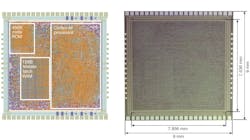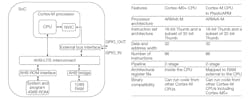Arm Researchers Create Flexible Cortex-M0 CPU on Plastic Substrate
Arm researchers have rolled out a prototype of what the company calls the world's first fully operational 32-bit Arm-based microprocessor based on a flexible plastic substrate instead of a brittle slab of silicon.
Arm said that it partnered with flexible electronics manufacturer PragmatIC to develop the plastic-based processor, which is based on its smallest, simplest—and also one of its most widespread microcontrollers—a 32-bit Cortex-M0+. Arm said it manufactured the prototype, PlasticARM, on a cheap plastic substrate that allows it to bend and twist without snapping, further opening the door to the Internet of Things era.
While significantly less powerful than modern microprocessors, Arm said that chips like PlasticARM could be ideal for use cases where cost, footprint, and flexibility of the electronics are the top priorities. The Arm researchers said the new flexible prototype raises the possibility of embedding billions of very inexpensive, ultra-thin, form-fitting microprocessors inside clothing, labels, food packaging, and other common objects.
Full details about the development of the chip were published in the journal Nature.
Along with its microprocessor-grade Cortex-A portfolio of CPU cores used in smartphones, Arm sells its Cortex-M range of microcontrollers for Internet of Things devices that fit in a very compact die area and consume a small amount of power. The minimalist M0 is also routinely used as a deeply embedded CPU core in a larger chip. Chips based on the M0 CPU core, which Arm rolled out more than a decade ago, run at clock frequencies of around 100 MHz and tend to cost in the $1 to $5 range depending on its features.
By using flexible substrates such as plastic, Arm said that it is possible to mass-produce PlasticARM and similar chips more affordably—orders of magnitude cheaper than silicon chips—and apply them in such a way that they conform to curved or uneven surfaces. With economies of scale, these chips could become cost-effective enough to be added to food packaging and other products that can be discarded, Arm said.
Companies could use chips like PlasticARM in areas where silicon is barred by the cost or rigid inflexibility of the material. The chip could be placed in food packaging and paired with sensors to determine whether the contents are spoiled, replacing the use of paper labels with sell-by-dates. It could also be embedded in a bandage, slapped on the human body to measure temperature or other metrics, and then thrown away.
Flexible electronics are based on alternate substrates, including paper, plastic, or metal foil instead of the slabs of rigid, brittle silicon used to craft the overwhelming majority of chips today. All the components of PlasticARM—the CPU, the RAM, ROM, and interconnects—are based on metal-oxide thin-film transistors (TFTs), also used in LCDs, LEDs, and other devices. These can also be manufactured on supple, plastic substrates more cheaply than metal-oxide-semiconductor field-effect transistors (MOSFETs) on silicon.
Arm, which sells chip blueprints and other intellectual property to vendors that build them into final chips, said that it started checking out the possibility of plastic CPUs for the Internet of Things almost a decade ago. The company rolled out one of the first prototypes of its flexible electronics in 2015. But it lacked the production, cell libraries, and other tools required to create a complete CPU on a flexible plastic substrate.
Arm said the PlasticARM was manufactured on PragmatIC’s 0.8-μm node with industry-standard chip design tools that it developed to solve the technical challenges standing in the way of more advanced plastic CPUs. These included a process design kit (PDK), a standard cell library, and simulation tools that worked with PragmatIC's FlexLogIC production. A standard cell library is a collection of small pre-verified building blocks that can be assembled into larger layouts using electronic design automation (EDA) tools.
While you can't actually buy an Arm-based processor like this yet, the researchers said PlasticARM shows that many of the building blocks of a plastic CPU—from tool flow to production—are no longer impractical.
Chips based on the M0+ CPU from NXP Semiconductors, ST Microelectronics, and others are generally mass-produced on the 40-nm and 90-nm process nodes. But the plastic M0+ processor measures 59.2 mm2, or more than 5,500 times the area of a 90-nm M0 CPU, according to Arm's Cortex-M0 datasheet.
The chip is based on a compact Cortex-M0+ CPU core with a minuscule 128 bytes of RAM and 456 bytes of ROM, while supporting the same 32-bit Armv6-M microarchitecture as silicon M0+ CPU cores. The chip can execute the 16-bit Arm Thumb instruction set architecture (ISA) and a subset of the 32-bit Thumb ISA. The M0+ is also surrounded by pins for clock signals, reset, debug, communications, and other purposes.
While Arm has prototyped other flexible chips, the PlasticArm chip stands out for its improved computing power. Modern processors contain billions of transistors organized into millions of logic gates, which are in turn grouped into more complicated parts such as memory caches. The PlasticARM only has around 38,000 transistors (nMOS, not the CMOS transistors used in modern processors) that are arranged into more than 18,000 logic gates, around 10 times the figure in previous state-of-the-art flexible electronics.
However, plastic-based CPUs still have weaknesses. These types of chips are not replacing silicon chips in the short term, which have major advantages in terms of power efficiency, performance, transistor density, and die area. The researchers said that PlasticARM is clocked at around 20 kHz, which is more than ten thousand times slower than the maximum frequency of a Cortex-M0+ chip based on 40-nm (280 MHz), according to Arm's Cortex-M0 datasheet.
The chip can so far run only run test programs pre-loaded into its ROM to test that the components work. Arm said future PlasticARMs could add on a larger amount of programmable memory to run other code.
One area of improvement Arm researchers are targeting is the chip's inefficiency. The prototype CPU burns through around 21 milliwatts (mW) of power, with around 99% of the power wasted in standby states, and 1% used for computational chores. That is thousands of times less power efficient than a 90-nm M0 CPU. The processor accounts for 45%, the memory 33%, and the I/O 22% of PlasticARM's overall power budget.
The Arm researchers hope to push the number of logic gates to more than 100,0000 in future generations of the PlasticARM processor. "Metal-oxide TFTs are low cost and can also be scaled down to the smaller geometries required for large-scale integration," the researchers said in their paper. But moving to more than 1,000,000 logic gates in a single die will probably require the use of CMOS technology, they said.
“As ultra-low-cost microprocessors become commercially viable, all sort of markets will open with interesting use cases such as smart sensors, smart labels and intelligent packaging," said John Biggs, distinguished engineer at Arm Research. He added: “This technology really lends itself to building intelligent disposable health monitoring systems that can be applied directly to the skin.”
About the Author
James Morra
Senior Editor
James Morra is the senior editor for Electronic Design, covering the semiconductor industry and new technology trends, with a focus on power electronics and power management. He also reports on the business behind electrical engineering, including the electronics supply chain. He joined Electronic Design in 2015 and is based in Chicago, Illinois.



